Sandstone fireplaces are a perfect way to add a unique charm and style to any home. With their natural colors and textures, they can blend seamlessly with furniture, providing an eye-catching focal point for any room. As a result, fitting a fireplace made of sandstone can be a good investment for homeowners who want to create a cozy and inviting atmosphere in their living space.
However, keeping such a feature looking its best requires regular maintenance and cleaning. In this article, we provide maintenance tips and easy-to-follow steps for cleaning your sandstone fireplace. From potentially hazardous materials to the most effective cleaning products, obtaining optimum results with ease is possible. So, grab your bucket and let’s get started!
Cleaning a sandstone fireplace requires gentle care and attention. Begin by brushing the surface with a soft brush, preferably with natural bristles, using soap and warm water.
“Keeping your sandstone fireplace clean does not have to be a daunting task. Utilizing a diluted pH neutral cleaner instead of acidic or basic products, along with a soft-bristle brush, can help in mitigating erosion, whilst maintaining the natural elegance of the stone. After all, taking care of our homes means knowing how to care for all the intricate details, and your fireplace deserves the same attention.”
Penelope Sinclair, Geologist
How to Clean a Sandstone Fireplace
Cleaning a sandstone fireplace is a delicate process that should be done with care. While stone fireplaces are strong and durable, avoid using harsh chemicals or abrasive brushes or tools that could cause damage. Also, take precaution before handling products with high toxicity. Consider wearing rubber gloves and protective eyewear.
Cleaning sandstone starts by using a dry rag to gently remove dust and debris from the surface. To remove any tough stuck-on dirt and grime, this should be followed up by wetting a rag and lightly scrubbing the area. For stubborn spots such as those created by a fire, consider using specialized imported stone cleaners. Keeping in mind, they can be damaging to natural stone depending on their composition. In this case, test a bit of the solution on a small hidden area before proceeding with the job in larger areas.
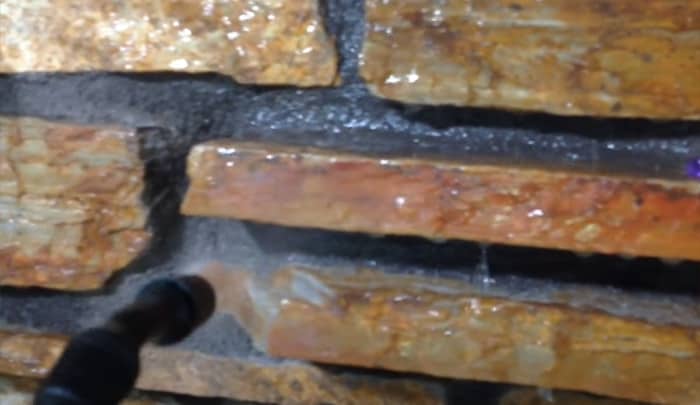
That being said, for preserving a sandstone fireplace – prevention is always better than cure. To ensure no debris or soot builds up, regularly keep up light maintenance and dusting of the fireplace. This reduces deep cleaning while protecting the sandstone over time.
Having outlined these cleaning methods, we move onto discussing more advanced techniques for maintenance and dust removal.
- Sandstone is highly sensitive to acids and alkalis and therefore requires special cleaning and care.
- A soft scrub brush works best for removing dirt from the surface of a sandstone fireplace.
- Stone soap (such as Castile soap or mild detergent) is recommended for routine cleaning of a sandstone fireplace by the International Masonry Institute.
Tips for Effective Maintenance & Dust Removal
As stated, regular maintenance is key to keeping sandstone clean. Periodically dusting off the surface will keep it looking its best. This ensures capturing any debris or ash before becoming deeply embedded in the stone clean. Periodically dusting off the surface will keep it looking its best. This ensures capturing any debris or ash before becoming deeply embedded in the stone. Soft texture cloths, microfiber dusters, and vacuum attachments can all be used to free dust or general dirt buildup.
For heavier buildup of debris, refrain from using abrasive scrubbers or cleaning products. These can damage the sandstone over time by removing its protective sealant layer. Instead, consider gentle cleaning methods for stone surfaces to preserve the integrity of your fireplace. For stubborn dirt and grime, non-abrasive, gentler cleaning methods should be employed as they are more effective at removing tough spots without damaging the stone itself. Using baking soda mixed with water to make a paste solution can help safely remove tougher spots when applied with a soft cloth.
Debate 💬
Some argue basic maintenance by dusting the sandstone is enough to maintain its appearance. While others believe using a gentle cleaning solution is necessary in order to “really” protect and preserve the material itself. Additionally, some believe using harsher cleaners could have adverse effects, due to the nature of sandstone being a soft material, while others argue harsher cleaners may be used if diluted properly with water to minimize damage to the stone. However, many agree that baking soda and water is a viable cleaning product for maintenance and dust removal!
No matter which method is preferred, dust removal should be done regularly!
With this in mind, let’s move onto what solutions to use for cleaning and how to keep it looking its best for years to come.
Ways for Using Chemical Solution for Sandstone
Using a solution to clean sandstone is an effective and efficient way of restoring its beauty. There are numerous products to use when cleaning the stone, including specially designed sandstone cleaner or homemade diluted white vinegar.
For those who prefer making their own cleaning solution, mild detergent and water can be combined to form a solution that’s safe for the environment and won’t damage the surface of the sandstone. Rinse away the detergent thoroughly using a damp paintbrush (or toothbrush), to prevent any soap residue from remaining on the surface. The brush bristles are effective for getting into the nooks and crannies of sandstone.
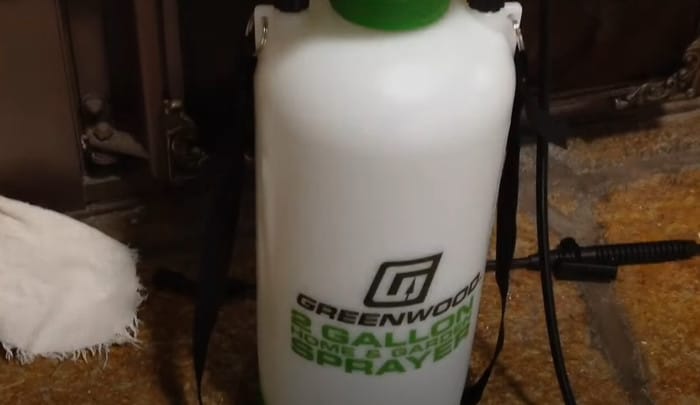
Alternatively, some house owners use harsher chemicals such as chlorine bleach or sulfuric acid, often because they believe this will get rid of stubborn stains faster than using a milder detergent-based solution. Understand, these stronger chemicals run the risk of damaging and discoloring your stone fireplace if mishandled. It is best left to professionals when dealing with stubborn stains.
Note: Certain chemicals may cause irreversible damage to the sandstone – even with professional help!
Now that we have discussed the benefits and potential risks associated with using chemical solutions, it’s time to move onto safety precautions to taken before beginning any kind of cleaning procedure.
Essential Safety Precautions for Cleaning Sandstone
Safety is paramount when cleaning, particularly a fireplace where dust, ashes and other materials can settle in the air. These are potential health risks. Goggles and protective gloves should be worn. In addition, proper ventilation should be accounted for by opening up windows and doors in the site where the cleaning will take place.
When using chemical fluids, it’s important to consider both your safety and that of others. On the one hand, these agents are effective cleaners,but on the other, they can be toxic. Use them sparingly and with caution – a respiratory mask prevents inhalation of toxic fumes.
It’s imperative to err on the side of precaution and, with that in mind, let’s move onto the next step – wearing protective gear while handling bricks during the cleaning process.
Importance of Wearing Protective Gear
When cleaning your sandstone fireplace, it’s imperative to wear protective gear. Not only is there the possibility of dust and dirt particles entering the air, but depending on the type of cleaner being used, improper handling or inhalation may lead to serious physical harm.
Protective rubber gloves will help protect your hands from chemical burns. Long sleeve shirts and pants will reduce the risk of skin damage caused by cleaners coming in contact with exposed skin. Additionally, a face mask will help filter out any dust particles or hazardous chemicals that could cause respiratory irritation.
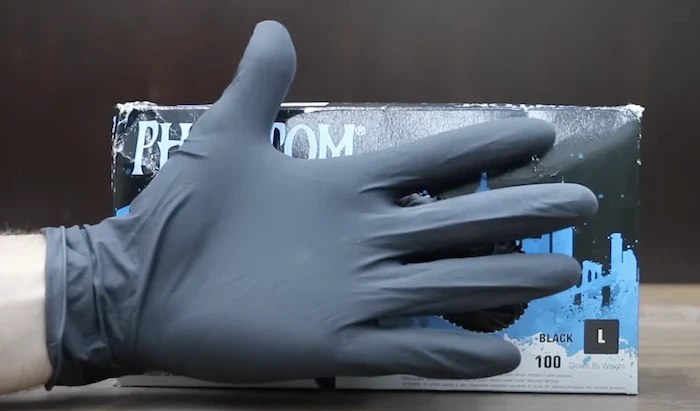
While wearing protective gear is important for safety, it’s equally important to ensure using appropriate gear. For example, a pair of thin latex gloves might not be sufficient to protect against chemicals and solvents.
Now that we have discussed protective gear, let’s move on to the different types of cleaning products that should be used.
Selecting the Right Cleaning Products
While stronger products such as bleach and ammonia are effective in cleansing sandstone, they pose a risk to the stone’s durability, not to mention your physical health if not handled correctly.
Acids should be used sparingly and with proper safety precautions; citrus-based solutions are a better option for the majority of light-duty cleanings. Always make sure to read the label on any product before using it. Test them on a small area of the stone first to ensure that they won’t damage or etch it. Test them on a small area of the stone first to ensure that they won’t damage or etch it.
Did you know?
Sandstone is a porous material, so it is important to use a gentle cleaning solution when cleaning a sandstone fireplace. You do not want chemical solutions seeping into the stone!
For tougher buildups, consider hiring a professional power washing service. As always, check with a certified mason for more guidance about what’s best for your unique situation.
Now that we have discussed proper cleaning products for sandstone fireplaces, let’s move on to more mild cleaning solutions and acids in the next section.
Mild Cleaning Solutions
Sandstone fireplaces may require various types of cleaning solutions, depending on their condition. Mild cleaning solutions, such as diluted cleaner or dish soap, are appropriate for removing light soot from sandstone fireplaces. If a deeper clean is needed then mild acids may be used. These acids must be used with caution and should never be used in excess.
Acids-based Solutions
The use of acid-based products can cause discoloration to the stone and weaken its surface over time. While the occasional use of acids can help tackle stubborn stains, it is recommended that these products be avoided on a regular basis. Alternatively, using an abrasive brush with a mild detergent may also work to help remove stubborn stains without the use of acidic solutions.
Although mild cleaning solutions and acids present both benefits and drawbacks when trying to clean a sandstone fireplace, these methods should always be approached with caution as improper application could potentially damage the stone. One should take into consideration the type of stone before selecting which method is best for their needs.
To ensure your sandstone fireplace is properly cleaned, it’s important to follow the proper steps in order to do so safely and effectively. The following section covers all aspects of the cleaning procedure, including how to clean different parts of your fireplace, such as the slate hearth.
Cleaning Procedure
Cleaning a sandstone fireplace is time-consuming, but if done properly, will greatly enhance the appearance of your fireplace (especially if you also clean the firebox). The cleaning procedure will depend on the type of build up and how heavily it is soiled. In general, it is best to start with a gentle cleaner first and build up to an abrasive cleaner if necessary.
The following steps will help guide you through the cleaning process:
- Vacuum loose debris off the sandstone and around the fireplace area before proceeding with a cleaner. If you have a wooden floor, use a protective sheet over it before starting.
- Test the cleaner of choice in an inconspicuous area to make sure it won’t cause discoloration or damage.
- Once a cleaner is selected, mix it according to the manufacturer’s instructions and apply it to the sandstone in small sections at a time. Use a soft bristled brush or sponge and work the space slowly and gently. Avoid applying too much pressure as this may cause scratches or etching.
- Rinse off the areas where the cleaner was used with clean water and blot dry with a soft cloth or towel. Do not allow water to dry on the sandstone as this could lead to staining or discoloration.
- Repeat the process until all areas have been worked through.
- Allow the fireplace to dry completely before use.
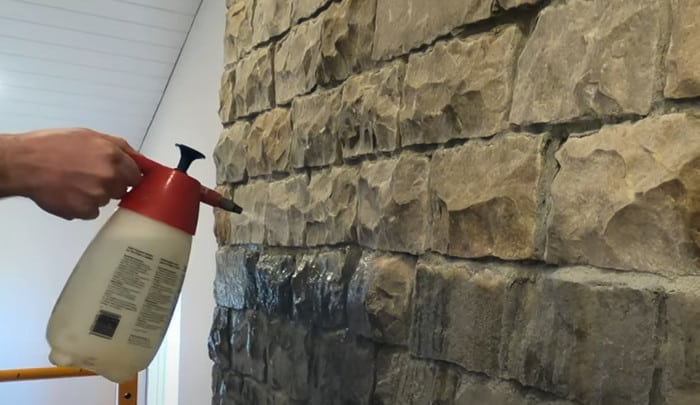
The next step in cleaning a sandstone fireplace is to choose and prepare a safe and appropriate cleaner for use on your specific type of stone surface.
Choosing and Preparing the Cleaner
The type of cleaner used to clean sandstone makes a difference in the results.
There is no one right method for cleaning sandstone, as different types of soiling may be present with different levels of stains. Therefore, each project has to be assessed separately to decide what method would work best.
From experience, there are two types of cleaners that work well – natural and chemical-based solutions!
Natural cleaners use components such as oils and soaps that help break up grime without damaging the stone. Examples of natural cleaners can include Castile soap and non-abrasive oils that don’t contain synthetic dyes, fragrances or additives. Natural products tend to be gentler than harsh chemical cleaners, but generally take more effort to remove stubborn stains or residue.
Chemical-based cleaners use a variety of commercial products with ingredients that can dissolve grease and grime quickly and easily. Many are found at home improvement or hardware stores, or online and come in both liquid and powder form. The downside with many chemical-based cleaners is that they are abrasive and can harm the surface of the stone if not used properly. Furthermore, some may have strong odors that cause irritation to those who have respiratory sensitivities.
As always, read the instructions carefully and consider environmentally friendly cleaners when possible.
Now it’s time to move on to washing the sandstone gently.
Technique for Gently Rinsing Sandstone
The idea is to be gentle with the material. Sandstone is soft and can damage easily by harsh chemicals and scrubbing. The best approach is to wash the sandstone with a mild detergent or cleanser mixed in warm water. Using a soft cloth or sponge, gently wipe down the entire surface until all the dirt, grease and grime have been removed. Allow the cleaning solution to sit on the sandstone for several minutes before wiping off any remaining residue.
Soak up any remaining cleaning solution using a clean towel or cloth before proceeding to the next step – routine care.
Debate 💬
Some people argue more abrasive natural cleaners, such as baking soda and vinegar, are needed for tougher stains. It is true that baking soda and vinegar are effective against stubborn stains, but this combination should only be used in extreme cases. Baking soda and vinegar will remove the dirt but can strip away natural oils from your sandstone and cause fading over time.
Routine Care Tips & Best Practices
Keeping sandstone fireplaces looking their best requires regular maintenance. This also ensures safety and high performance . Maintenance can include brushing away any dirt, wiping down the surface with a clean cloth, and polishing with a non-abrasive cleaner.
In many cases, routine cleaning may not be necessary. A light dusting with a soft brush may be all that’s required to remove loose particles. If the surface needs more attention, use a mild detergent and warm water solution followed by a thorough dry session. At this point avoid any harsh or acidic cleaners as these will damage the stone over time.
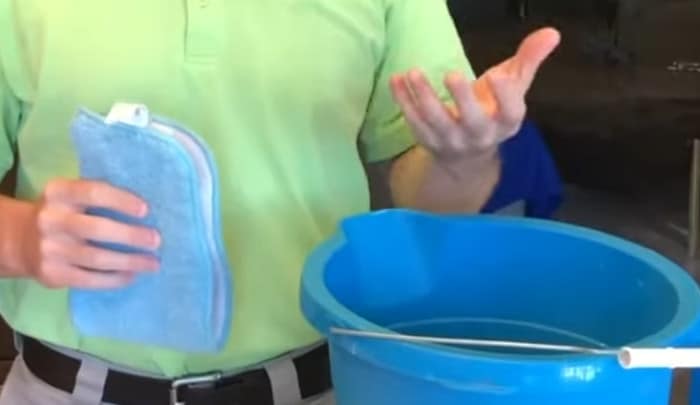
Polishing with a wax or oil product can enhance the look of the fireplace. Natural stone products (such as sandstone) often benefit from a protective sealant for protection. Before applying any products, follow the manufacturer’s directions on the information label to ensure proper care and protection. Avoid abrasive scrubbers when cleaning, and only use non-abrasive materials for polishing.
There are two schools of thought when it comes to routine care: some prefer to maintain the natural appearance of their fireplace without wax or sealants and just dust occasionally; while others feel wax and other products help protect the material and keep it looking newer for longer. Ultimately, it’s your choice!
Common Questions Answered
1. How often do I need to clean a sandstone fireplace to keep it in good condition?
More frequent cleaning may be necessary if the fireplace is used often or in certain climates where sandstone is particularly susceptible to damage from elements such as sun, rain, and snow. Additionally, it’s important to conduct a deep cleaning of your sandstone fireplace at least once a year to ensure that any accumulated dirt and debris is removed. Taking these steps will help keep your sandstone fireplace looking great for years to come!
2. What materials do I need to clean a sandstone fireplace?
Gentle Cleaner or Detergent: For cleaning the fireplace, use a gentle cleaner or detergent that’s designed for stone. Avoid harsh abrasive cleaners as these can damage the surface of the sandstone.
Soft Bristle Brush or Sponge: Use a soft bristle brush (or sponge) to gently scrub any residue from the surface. A stiff brush may cause damage.
Water & Towels: You will need to use water and towels to rinse the area after applying detergent or cleaner. Ensure all the soap has been rinsed away before drying the area with towels.
Vacuum Cleaner: If there is build-up in hard to reach places, like corners, crevices, or in between bricks, use a vacuum cleaner with a brush attachment.
Protective sealer: Once everything is cleaned, it’s important that you apply a sealant to protect the stone from dirt and discoloration buildup.
Cleaning a sandstone fireplace requires patience and care. Make sure that you always read manufacturer instructions and safety advice when using detergents and cleaners. Following these steps should ensure that your fireplace looks its best for years to come!
3. What is the best way to remove dirt, dust, and stains from a sandstone fireplace?
Afterwards, mix a pH-neutral cleaner with warm water, apply it to the surface of the fireplace, and let it sit for 5 minutes before scrubbing it with a soft cloth or brush. For tough stains, it’s best to use an alkaline cleaning solution such as ammonia, bleach, or vinegar. Once the dirt and stains are 1done, rinse thoroughly with clean water and dry with a soft cloth.
✂– – – – – – – – – – – – – – – – – – – –
References & Sources
https://qualitygraniteandmarble.com/what-type-of-stone-is-best-for-a-fireplace-surround/

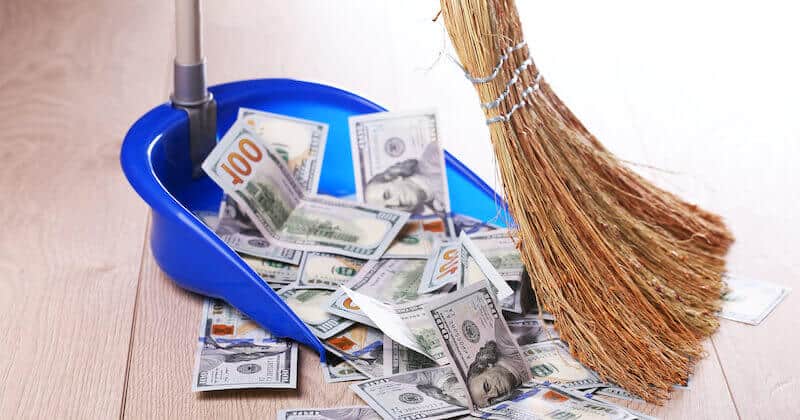
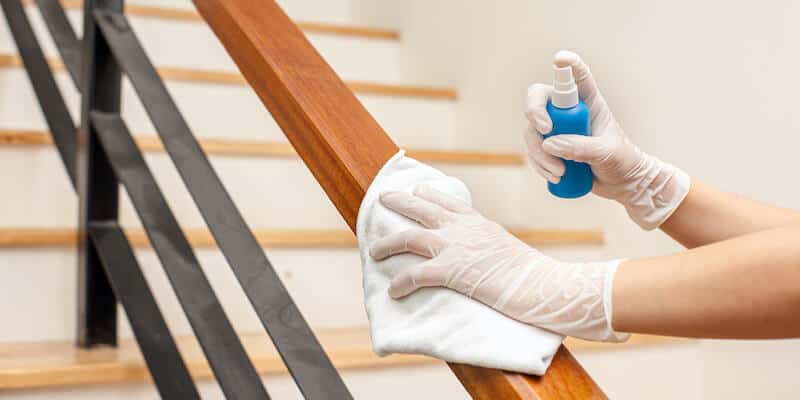


Back when I installed my sandstone fireplace about 20 years ago, I was quite naive about its maintenance. After using a commercial cleaner which left a horrible stain, I learnt the hard way how essential it is to stick to pH-neutral cleaning solutions. I fabricated a concoction made up of liquid soap and baking soda and have been using it for the past 15 years with great results. Don’t forget, a gentle hand and a soft bristle brush is key to keep the natural texture of the sandstone intact.
I’ve also had to experiment with cleaning methods for my own sandstone fireplace, Everett. I found that using a steam cleaner followed by a pH-neutral cleaner removed even tough grime without damaging the stone’s natural beauty.
Peony, I concur with your method. Steam cleaners indeed do wonders for sandstone fireplaces and using a pH-neutral cleaner afterward helps protect the stone’s natural beauty without any detrimental effect.
From my experience as a geologist and having maintained my own sandstone fireplace for decades, steam cleaning can indeed be effective but excessive usage can possibly cause damage due to the heat and pressure involved. A gentle scrub with a soft brush and mild soapy water can also achieve good results without posing a risk to this precious sedimentary rock.
I appreciate Quinton’s insight from a geologist’s perspective – very enlightening! However, as a homeowner who has successfully maintained their own sandstone fireplace over the last 20 years, I’d argue for the occasional use of steam cleaning. So long as it’s done responsibly and not excessively – perhaps every other year. Also ensuring the pressure is set to low to avoid causing undue stress on the stone.
Emrys, I agree with the occasional use of steam cleaning but completely resonate with your point about low pressure on the stone – having accidentally damaged a portion of my fireplace when initially unaware of these precautions.